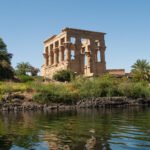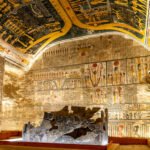Planning your dream Egypt itinerary? Start by diving into the heart of Ancient Egypt with an unforgettable journey to Luxor and Aswan. These timeless cities offer a perfect blend of history, culture, and relaxation. From awe-inspiring temples to peaceful felucca rides, the list of activities to do in Aswan and Luxor is truly endless. Among the most iconic Luxor and Aswan attractions are grand monuments, sacred tombs, and living cultural heritage that reflect the greatness of Ancient Egypt. Whether you’re tracing the footsteps of pharaohs through majestic ruins or simply soaking in the atmosphere of these historic lands, this adventure promises a magical glimpse into Egypt’s golden past. Get ready to explore the wonders that make this region a must-visit for every traveler.
Attraction places in Luxor :
1- The Luxor Temple

One of the largest Ancient Egyptian Temples complex located on the east bank of the Nile River in the city today known as Luxor (ancient Thebes) and was constructed approximately 1400 BCE. It is also known for its well-preserved structures, statuary, and relief carvings. The temple is famous for its connection to the Festival of Opet, a major ancient Egyptian celebration, and for its Avenue of Sphinxes, which once linked it to the Karnak Temple as we are talking in the following
2- The karnak Temple
The Karnak Temple complex is one of the largest religious structures ever built. Dedicated primarily to the god Amun-Ra, it includes a massive hypostyle hall with 134 towering columns, sacred lakes, obelisks, and chapels. Karnak represents over 2,000 years of construction by different pharaohs, making it one of the most impressive things to see in Luxor.
2. Valley of the Kings
This world-famous necropolis served as the final resting place for the pharaohs of the New Kingdom, including Tutankhamun and Ramses II. Hidden beneath the Theban cliffs, the tombs are richly decorated with colorful hieroglyphs and scenes from the afterlife. The Valley of the Kings is a must-visit for anyone wanting to walk in the footsteps of ancient royalty.
3. Valley of the Queens
Not far from its more famous counterpart, the Valley of the Queens houses the tombs of royal wives, daughters, and princes. The most stunning is the Tomb of Queen Nefertari, renowned for its exquisite artwork and vibrant colors. This site adds a personal and intimate layer to your understanding of royal life in ancient Egypt.
4. Colossi of Memnon
Standing guard at the entrance to the Theban Necropolis, the Colossi of Memnon are two massive statues of Pharaoh Amenhotep III. Though damaged by time and earthquakes, they remain awe-inspiring. Visitors often stop here on their way to other Luxor attractions, making it a symbolic welcome to the West Bank’s historical sites.
5. Temple of Hatshepsut
Carved directly into limestone cliffs at Deir el-Bahari, the Temple of Hatshepsut is a masterpiece of ancient architecture. Built for Egypt’s most powerful female pharaoh, the temple’s terraces and colonnades rise in harmony with the surrounding mountains. It’s a perfect combination of natural beauty and human achievement.
6. Luxor Museum
Located on the East Bank of the Nile, Luxor Museum offers a curated experience of ancient artifacts found in and around the city. Its collection includes statues, jewelry, mummies, and items from Tutankhamun’s tomb. The museum provides rich context for the monuments and is ideal for travelers who want to go deeper into ancient Egyptian history.
You might have Questioned what else i can do in Luxor and this is the answer to your question:
Other Activities:
- Hot Air Balloon: ride over Luxor can be a magnificent, unforgettable highlight floating above Karnak, the Nile, Valley of the Kings, and desert plains at sunrise is absolutely bucket-list worthy.
- Luxor sound and light show: brings ancient Egyptian history to life under the stars. Held at the awe-inspiring Karnak Temple complex in the City of Luxor
- Felucca ride: a way to explore the timeless beauty of the Nile River and choose a peaceful daytime cruise or romantic sunset ride.
- Explore the Souks: Wander through Luxor’s bustling markets, experiencing the local culture and shopping for souvenirs.
- Quad Biking/Desert Safari:For adventurous travelers, quad biking and desert safaris offer a thrilling way to experience the surrounding landscape.
- Cooking Class:Participate in a cooking class to learn how to prepare traditional Egyptian dishes.
- Horse-drawn Carriage Ride: Take a leisurely ride along the Corniche, enjoying the views of the Nile.
- Visit Deir el-Medina: Explore the village of the artisans who worked on the royal tombs.
Attraction places in Aswan:
1. Philae Temple
Philae Temple stands proudly on Agilkia Island and is dedicated to the goddess Isis. The temple is admired for its elegant columns, mythological carvings, and harmonious layout. Saved from rising Nile waters by UNESCO, it remains a symbol of devotion and preservation. Visitors reach it by boat, making the experience even more memorable.
2. Aswan High Dam
An engineering feat that changed Egypt’s destiny, the Aswan High Dam tamed the Nile and created Lake Nasser. It provides essential electricity and water control for the country. Tourists can walk along the dam’s top to enjoy sweeping views and learn how this modern project saved ancient monuments from flood.
3. Felucca Ride on the Nile
A felucca ride at sunset is one of Aswan’s most calming experiences. These traditional sailboats carry you past Elephantine Island, palm-covered banks, and golden sand dunes. The slow, rhythmic motion and peaceful atmosphere are perfect for reflection, photography, or a romantic moment on the Nile.
4. Nubian Village
Nubian villages near Aswan offer a glimpse into a vibrant and welcoming culture. Painted in bright colors and full of life, these communities invite visitors to explore local homes, taste Nubian cuisine, and enjoy folk music and storytelling. It’s an enriching, off-the-beaten-path experience.
5. Unfinished Obelisk
Still attached to the granite quarry floor, the Unfinished Obelisk reveals how ancient Egyptians carved their monuments. Estimated to weigh 1,200 tons, it cracked during construction and was abandoned, but it remains a fascinating open-air museum of ancient techniques and tools.
6. Aswan Botanical Garden
Located on Kitchener’s Island, this garden is a haven for plant lovers. Filled with exotic trees and flowers from Asia, Africa, and beyond, it offers shady paths and Nile breezes. It’s ideal for a peaceful afternoon walk or a quiet picnic in nature.
7. Tombs of the Nobles
Overlooking the Nile, these tombs house the remains of high officials from Egypt’s Old and Middle Kingdoms. Inside, detailed paintings depict daily life and spiritual beliefs. Few tourists venture here, so visitors enjoy stunning views and peaceful exploration.
8. Temple of Kalabsha
The Temple of Kalabsha is a hidden gem on the shores of Lake Nasser. Dedicated to the Nubian god Mandulis, the temple was moved stone by stone to escape flooding. Its fine carvings and Roman-influenced design offer a unique contrast to older Pharaonic sites.
Conclusion:
Luxor and Aswan stand as open-air museums where history, spirituality, and natural beauty blend seamlessly. From the towering columns of Karnak Temple to the vivid tombs in the Valley of the Kings, Luxor offers a powerful journey into the world of ancient Egyptian royalty and religion. Just to the south, Aswan welcomes visitors with its calm Nile views, colorful Nubian culture, and iconic sites like Philae Temple and the Unfinished Obelisk. Together, these two destinations provide a rich contrast—one echoing with the grandeur of the pharaohs, the other soothing the soul with serenity and heritage. Whether you’re a history lover, a culture seeker, or simply in search of unforgettable views, the attractions in Luxor and Aswan promise an experience like no other.






